Numerical Simulation of the Effect of a Single Gust on the Flow Past a Square Cylinder
Abstract
:1. Introduction
2. Materials and Methods
2.1. Numerical Code
2.2. The Flow Field Past a Square Cylinder
2.3. Gust Introduction
3. Results and Discussion
3.1. VLES Validation of Flow Past a Square Cylinder
3.2. Gust Introduction in Flow Past a Square Cylinder
4. Discussion and Conclusions
Author Contributions
Funding
Data Availability Statement
Conflicts of Interest
References
- Boettcher, F.; Renner, C.; Waldl, H.P.; Peinke, J. On the statistics of wind gusts. Bound. Layer Meteorol. 2003, 108, 163–173. [Google Scholar] [CrossRef]
- Yan, B.; Chan, P.; Li, Q.; He, Y.; Cai, Y.; Shu, Z.; Chen, Y. Characterization of Wind Gusts: A Study Based on Meteorological Tower Observations. Appl. Sci. 2022, 12, 2105. [Google Scholar] [CrossRef]
- Wu, Z.; Cao, Y.; Ismail, M. Gust loads on aircraft. Aeronaut. J. 2019, 123, 1216–1274. [Google Scholar] [CrossRef]
- Granlund, K.; Monnier, B.; Ol, M.; Williams, D. Airfoil longitudinal gust response in separated vs. attached flows. Phys. Fluids 2014, 26, 027103. [Google Scholar] [CrossRef]
- Montenegro, P.A.; Heleno, R.; Carvalho, H.; Calcada, R.; Baker, C.J. A comparative study on the running safety of trains subjectedto crosswinds simulated with different wind models. J. Wind Eng. Ind. Aerodyn. 2020, 207, 104398. [Google Scholar] [CrossRef]
- Rakib, M.I.; Evans, S.P.; Clausen, P.D. Measured gust events in the urban environment, a comparison with the IEC standard. Renew. Energy 2020, 146, 1134–1142. [Google Scholar] [CrossRef]
- Quan, Y.; Wang, S.; Gu, M.; Kuang, J. Field measurement of wind speeds and wind-induced responses atop the shanghai worldfinancial center under normal climate conditions. Math. Probl. Eng. 2013, 2013, 902643. [Google Scholar] [CrossRef]
- Wu, Y.; Li, Q.; Li, G.; He, B.; Dong, L.; Lan, H.; Zhang, L.; Chen, S.; Tang, X. Vertical Wind Speed Variation in a Metropolitan City inSouth China. Earth Space Sci. 2022, 9, e2021EA002095. [Google Scholar] [CrossRef]
- Da Rosa, C.E.; Stefanello, M.; Facco, D.S.; Roberti, D.R.; Rossi, F.D.; Nascimento, E.L.; Degrazia, G.A. Regional-scale meteorological characteristics of the Vento Norte phenomenon observed in Southern Brazil. Environ. Fluid Mech. 2022, 22, 819–837. [Google Scholar] [CrossRef]
- Van de Walle, J.; Thiery, W.; Brogli, R.; Martius, O.; Zscheischler, J.; van Lipzig, N.P.M. Future intensification of precipitation and wind gust associated thunderstorms over Lake Victoria. Weather. Clim. Extrem. 2021, 34, 100391. [Google Scholar] [CrossRef]
- Jielan, X.; Changxing, L.; Honglong, Y.; Ruiquan, G.; Chao, L.; Baomin, W.; Pak, W.H.; Shaojia, F.; Lei, L. Tower-observed structural evolution of the low-level boundary layer before, during, and after gust front passage in a coastal area at low latitude. Weather. Clim. Extrem. 2022, 36, 100429. [Google Scholar]
- An, Y.; Quan, Y.; Gu, M. Field measurement of wind characteristics of Typhoon Muifa on the Shanghai world financial center. Int. J. Distrib. Sens. Netw. 2012, 8, 893739. [Google Scholar] [CrossRef]
- Wang, X.J.; Li, Q.S.; Yang, J.W. Non stationary near-ground wind characteristics and wind-induced pressures on the roof of a low-rise building during a typhoon. J. Build. Eng. 2022, 53, 104492. [Google Scholar] [CrossRef]
- Li, L.; Zhou, Y.; Wang, H.; Zhou, H.; He, X.; Wu, T. An analytical framework for the investigation of tropical cyclone wind characteristics over different measurement conditions. Appl. Sci. 2019, 9, 5385. [Google Scholar] [CrossRef]
- Piquee, J.; García-Risco, A.Á.; López, I.; Breitsamte, C.; Wüchner, R.; Bletzinger, K.U. Numerical investigations of a membrane morphing wind turbine blade under gust conditions. J. Wind. Eng. Ind. Aerodyn. 2022, 224, 104921. [Google Scholar] [CrossRef]
- Bai, H.; Aoues, Y.; Cherfils, J.M.; Lemosse, D. Design of an active damping system for vibration control of wind turbine towers. Infrastructures 2021, 6, 162. [Google Scholar] [CrossRef]
- Nasef, S.A.; Hassan, A.A.; Elsayed, H.T.; Zahran, M.B.; El-Shaer, M.K.; Abdelaziz, A.Y. Optimal Tuning of a New Multi-input Multi-output Fuzzy Controller for Doubly Fed Induction Generator-Based Wind Energy Conversion System. Arab. J. Sci. Eng. 2022, 47, 3001–3021. [Google Scholar] [CrossRef]
- Basker, I.; NainangkuppamVenkatesan, M. 3D-CFD flow driven performance analysis of new non-cylindrical helical vertical axis wind turbine for fluctuating urban wind conditions. Energy Sources Part A Recovery Util. Environ. Eff. 2022, 44, 2186–2207. [Google Scholar] [CrossRef]
- Iori, J. Design optimization of a wind turbine blade under non-linear transient loads using analytic gradients. J. Phys. Conf. Ser. 1618, 2020, 042032. [Google Scholar] [CrossRef]
- Parekh, C.J.; Roy, A.; Harichandan, A.B. Numerical simulation of incompressible gusty flow past a circular cylinder. AEJ Alex. Eng. J. 2018, 57, 3321–3332. [Google Scholar] [CrossRef]
- Afgan, I.; Benhamadouche, S.; Han, X.; Saugaut, P.; Laurence, D. Flow over a flat plate with uniform inlet and incident coherent gusts. J. Fluid Mech. 2013, 720, 457–485. [Google Scholar] [CrossRef] [Green Version]
- Golubev, V.V.; Dreyer, B.D.; Hollenshade, T.M. High-accuracy viscous analysis of unsteady flexible airfoil response to impinging gust. In Proceedings of the 15th AIAA/CEAS Aeroacoustics Conference, Miami, FL, USA, 11–13 May 2009. [Google Scholar]
- Bierbooms, W.; Cheng, P.W. Stochastic gust model for design calculation of wind turbine. J. Wind Eng. Ind. Aerodyn. 2002, 90, 1237–1251. [Google Scholar] [CrossRef]
- Bierbooms, W. A gust model for wind turbine design. JSME Int. J. Ser. B. 2004, 47, 378–386. [Google Scholar] [CrossRef]
- Available online: https://graphical.weather.gov/ (accessed on 13 August 2013).
- Kasperski, M. A consistent model for the codification of wind loads. J. Wind Eng. Ind. Aerodyn. 2007, 95, 1114–1124. [Google Scholar] [CrossRef]
- TC88 WG1. IEC 61400-1; Wind Turbines: Design Requirements. International Electrotechnical Commission: London, UK, 2005.
- Shirzadeh, K.; Hangan, H.; Crawford, C. Experimental and numerical simulation of extreme operational conditions for horizontal axis wind turbines based on the IEC standard. Wind. Energy Sci. 2020, 5, 1755–1770. [Google Scholar] [CrossRef]
- Huang, R.F.; Hsu, C.M.; Chiu, P.C. Flow behavior around a square cylinder subject to modulation of a planar jet issued from upstream surface. J. Fluids Struct. 2014, 51, 362–383. [Google Scholar] [CrossRef]
- Xiaoqing, D.; Ruyi, C.; Hanlin, X.; Wenyong, M. Experimental study on aerodynamic characteristics of two tandem square cylinders. Fluid Dyn. Res. 2019, 51, 055508. [Google Scholar] [CrossRef]
- Williamson, C. Vortex dynamics in the cylinder wake. Annu. Rev. Fluid Mech. 1996, 28, 477–539. [Google Scholar] [CrossRef]
- Zhang, D.; Cheng, L.; An, H.; Zhao, M. Direct numerical simulation of flow around a surface-mounted finite square cylinder at low Reynolds numbers. Phys. Fluids 2017, 29, 045101. [Google Scholar] [CrossRef]
- Wang, Y.Q. Effects of Reynolds number on vortex structure behind a surface-mounted finite square cylinder with AR = 7. Phys. Fluids 2019, 31, 115103. [Google Scholar] [CrossRef]
- Sohankar, A.; Norberg, C.; Davidson, L. Simulation of three-dimensional flow around a square cylinder at moderate Reynolds numbers. Phys. Fluids 1999, 11, 288. [Google Scholar] [CrossRef]
- Akamura, Y.N. Vortex shedding from bluff bodies and a universal Strouhal number. J. Fluids Struct. 1996, 10, 159–171. [Google Scholar] [CrossRef]
- Meng, H.; Chen, W.; Chen, G.; Gao, D.; Li, H. Characteristics of forced flow past a square cylinder with steady suction at leading-edge corners. Phys. Fluids 2022, 34, 025119. [Google Scholar] [CrossRef]
- Etheridge, D.W.; Sandberg, M. Building Ventilation: Theory and Measurement; John Wiley & Sons: Chichester, UK, 1996. [Google Scholar]
- Finnegan, M.; Pickering, C.A.; Burge, P.S. The sick building syndrome: Prevalence studies. Med.Br. J. 1984, 289, 1573–1575. [Google Scholar] [CrossRef] [PubMed]
- Tominaga, Y.; Blocken, B. Wind tunnel analysis of flow and dispersion in cross-ventilated isolated buildings: Impact of opening positions. J. Wind Eng. Ind. Aerod. 2016, 155, 74–88. [Google Scholar] [CrossRef]
- Tong, Z.; Chen, Y.; Malkawi, A. Defining the Influence Region in neighborhood scale CFD simulations for natural ventilation design. Appl. Energy 2016, 182, 625–633. [Google Scholar] [CrossRef]
- Hooff, T.; Blocken, B.; Tominaga, Y. On the accuracy of CFD simulations of cross-ventilation flows for a generic isolated building: Comparison of RANS, LES and experiments. Build. Environ. 2017, 114, 148–165. [Google Scholar] [CrossRef]
- Norberg, C. Flow around rectangular cylinders: Pressure forces and wake frequencies. J. Wind Eng. Ind. Aerodyn. 1993, 49, 187–196. [Google Scholar] [CrossRef]
- Luo, S.C.; Yazdani, M.G.; Chew, Y.T.; Lee, T.S. Effects of incidence and after body shape on flow past bluff cylinders. J. Wind Eng. Ind. Aerodyn. 1994, 53, 375–399. [Google Scholar] [CrossRef]
- Lyn, D.; Rodi, W. The flapping shear layer formed by flow separation from the forward corner of a square cylinder. J. Fluid Mech. 1994, 267, 353–376. [Google Scholar] [CrossRef]
- Lyn, D.A.; Einav, S.; Rodi, W.; Park, J.H. A laser-Doppler velocimetry study of ensemble-averaged characteristics of the turbulent near wake of a square cylinder. J. Fluid Mech. 1995, 304, 285–319. [Google Scholar] [CrossRef]
- Minguez, M.; Brun, C.; Pasquetti, R.; Serre, E. Experimental and high-order LES analysis of the flow in near-wall region of a square cylinder. Int. J. Heat Fluid Flow 2011, 32, 558–566. [Google Scholar] [CrossRef]
- Sohankar, A.; Davidson, L. Large eddy simulation of flow past a square cylinder: Comparison of different subgrid scale models. ASME J. Fluids Eng. 2000, 122, 39–47. [Google Scholar] [CrossRef]
- Rodi, W.; Ferziger, J.H.; Breuer, M.; Pourquié, M. Status of large eddy simulation: Results of a workshop. J Fluids Eng. Trans. ASME 1997, 119, 248–262. [Google Scholar] [CrossRef]
- Rodi, W. Comparison of LES and RANS calculations of the flow around bluff bodies. J. Wind Eng. Ind.Aerodyn. 1997, 6971, 55–75. [Google Scholar] [CrossRef]
- Trias, F.X.; Gorobetsab, A.; Olivaa, A. Turbulent flow around a square cylinder at Reynolds number 22,000: A DNS study. Comput. Fluids 2015, 123, 87–98. [Google Scholar] [CrossRef]
- Verstappen, R.W.C.P.; Veldman, A.E.P. Spectro-consistent discretization of Navier–Stokes: A challenge to RANS and LES. J. Eng. Math. 1998, 34, 163–179. [Google Scholar] [CrossRef]
- Barone, M.F.; Roy, C.J. Evaluation of detached eddy simulation for turbulent wake applications. AIAA J. 2006, 44, 3062–3071. [Google Scholar] [CrossRef]
- Speziale, C.G. Turbulence modeling for time-dependent RANS and VLES: A review. AIAA J. 1998, 36, 173–184. [Google Scholar] [CrossRef]
- Girimaji, S.S.; Srinivasan, R.; Jeong, E. PANS turbulence for seamless transition between RANS andLES: Fixed-point analysis and preliminary results. In Proceedings of the ASME/JSME 2003 4th Joint Fluids Summer Engineering Conference, Honolulu, HI, USA, 6–10 July 2003. [Google Scholar]
- Han, X.; Krajnovic, S. An efficient very large eddy simulation model for simulation of turbulent flow. Int. J. Numer. Meth. 2012, 71, 1341–1360. [Google Scholar] [CrossRef]
- Patankar, S.V.; Spalding, D.B. A calculation procedure for heat, mass and momentum transfer in three-dimensional parabolic flows. Int. J. Heat Mass Transf. 1972, 15, 1787–1806. [Google Scholar] [CrossRef]
- Papadakis, G.; Bergeles, G. A locally modified 2nd-order upwind scheme for convection terms discretization. Int. J. Fluids Struct. 1995, 9, 435–455. [Google Scholar]
- Barmpas, F.; Bouris, D.; Moussiopoulos, N. 3D Numerical Simulation of the Transient Thermal Behavior of a Simplified BuildingEnvelope Under External Flow. J. Sol. Energy Eng. 2009, 131, 031001. [Google Scholar] [CrossRef]
- Jurelionis, A.; Bouris, D.G. Impact of Urban Morphology on Infiltration-Induced Building Energy Consumption. Energies 2016, 9, 177. [Google Scholar] [CrossRef]
- Bouris, D.; Triantafyllou, A.G.; Krestou, A.; Leivaditou, E.; Skordas, J.; Konstantinidis, E.; Kopanidis, A.; Wang, Q. Urban-Scale Computational Fluid Dynamics Simulations with Boundary Conditions from Similarity Theory and a Mesoscale Model. Energies 2021, 14, 5624. [Google Scholar] [CrossRef]
- Stull, R. Practical Meteorology: An Algebra-Based Survey of Atmospheric Science; Dept. of Earth, Ocean & Atmospheric Sciences, University of British Columbia: Vancouver, BC, Canada, 2015. [Google Scholar]
- Letson, F.; Barthelmie, R.J.; Hu, W.; Pryor, S.C. Characterizing wind gusts in complex terrain. Atmos. Chem. Phys. 2019, 19, 3797–3819. [Google Scholar] [CrossRef]
- Wind tunnel studies of buildings and structures. In ASCE Manuals and Reports on Engineering Practice; No. 67; Isyumov, N. (Ed.) Aerospace Division of the American Society of Civil Engineers: Reston, VI, USA, 1999. [Google Scholar]
- Franke, R.; Rodi, W. Calculation of vortex shedding past a square cylinder with various turbulence models. In Turbulent Shear Flows 8; Springer: Berlin/Heidelberg, Germany, 1991. [Google Scholar]
- Bouris, D.; Bergeles, G. 2D LES of vortex shedding from a square cylinder. J. Wind Eng. Ind. Aerodyn. 1999, 80, 31–46. [Google Scholar] [CrossRef]
- Raisee, M.; Jafari, A. Numerical Study of Turbulent Flow around a Square Cylinder Using Two Low-Reynolds-Number K − ε Models. In European Conference on Computational Fluid Dynamics; Wesseling, P., Oñate, E., Périaux, J., Eds.; TU Delft: Delft, The Netherlands, 2006. [Google Scholar]
- Barbi, C.; Favier, D.; Maresca, C.; Telionis, D. Vortex shedding and lock-on of a circular cylinder in oscillatory flow. J. Fluid Mech. 1986, 170, 527–544. [Google Scholar] [CrossRef]
- Konstantinidis, E.; Bouri, D. Vortex synchronization in the cylinder wake due to harmonic and non-harmonic perturbations. J. Fluid Mech. 2016, 804, 248–277. [Google Scholar] [CrossRef]

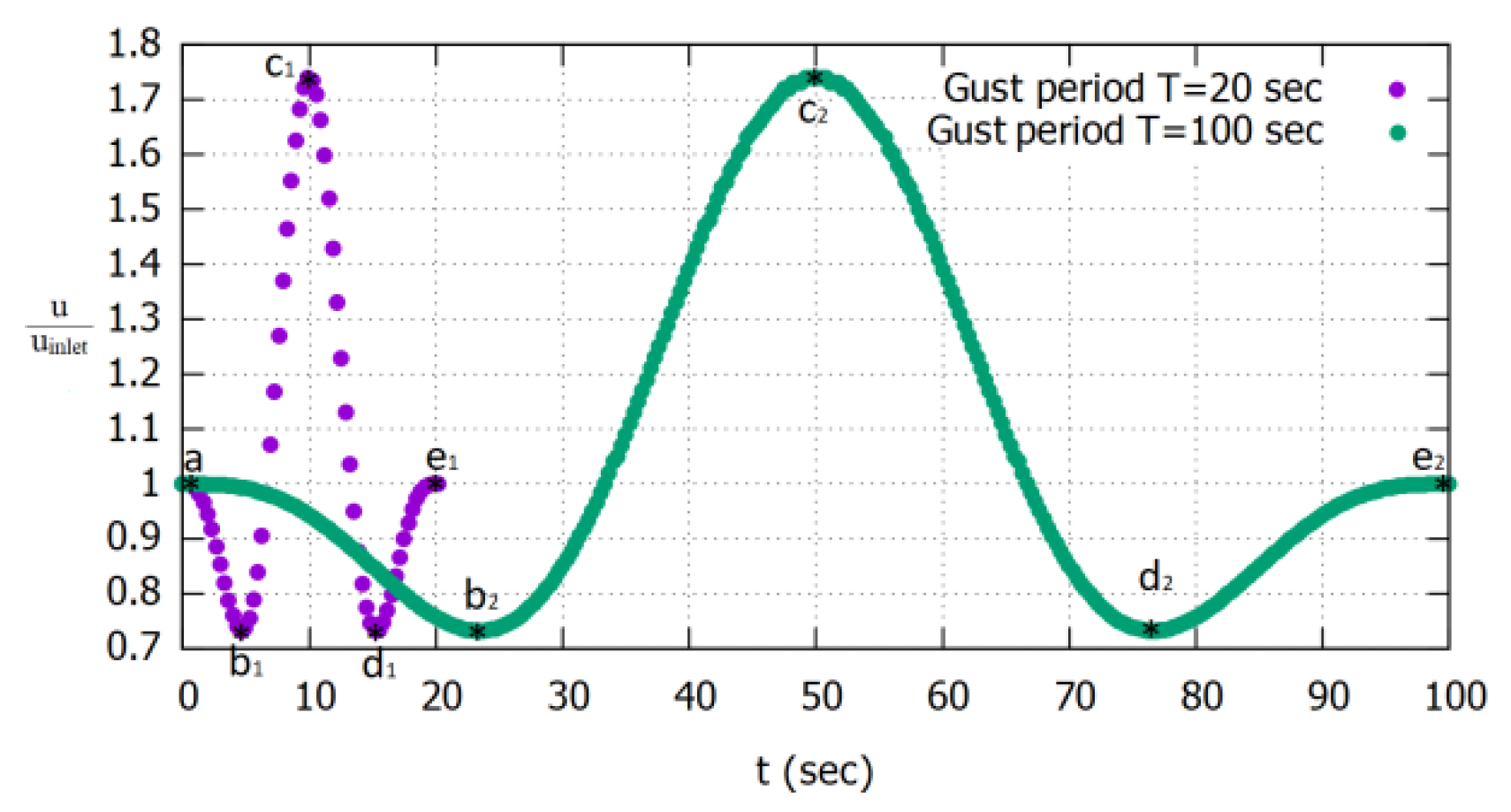
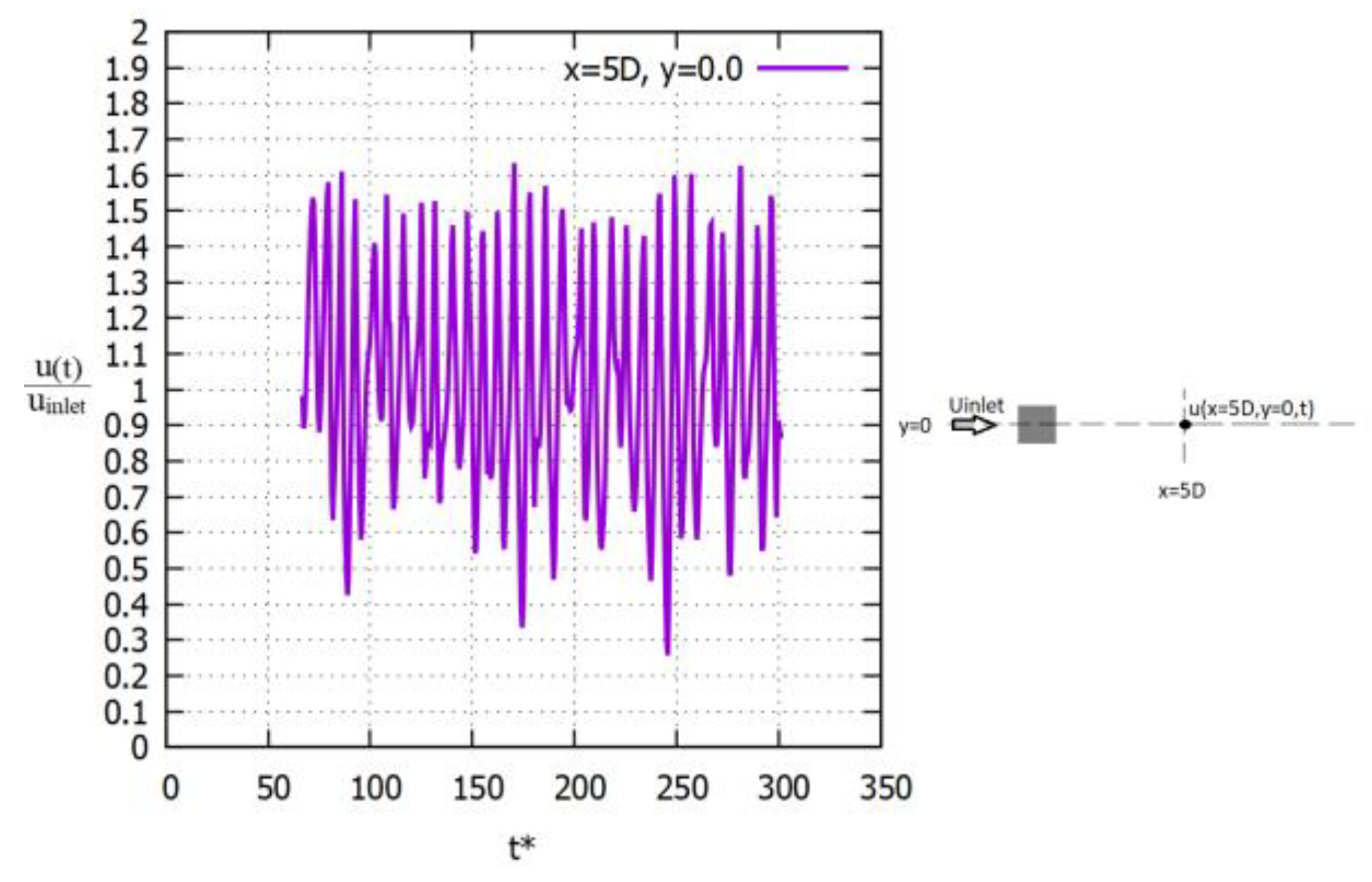
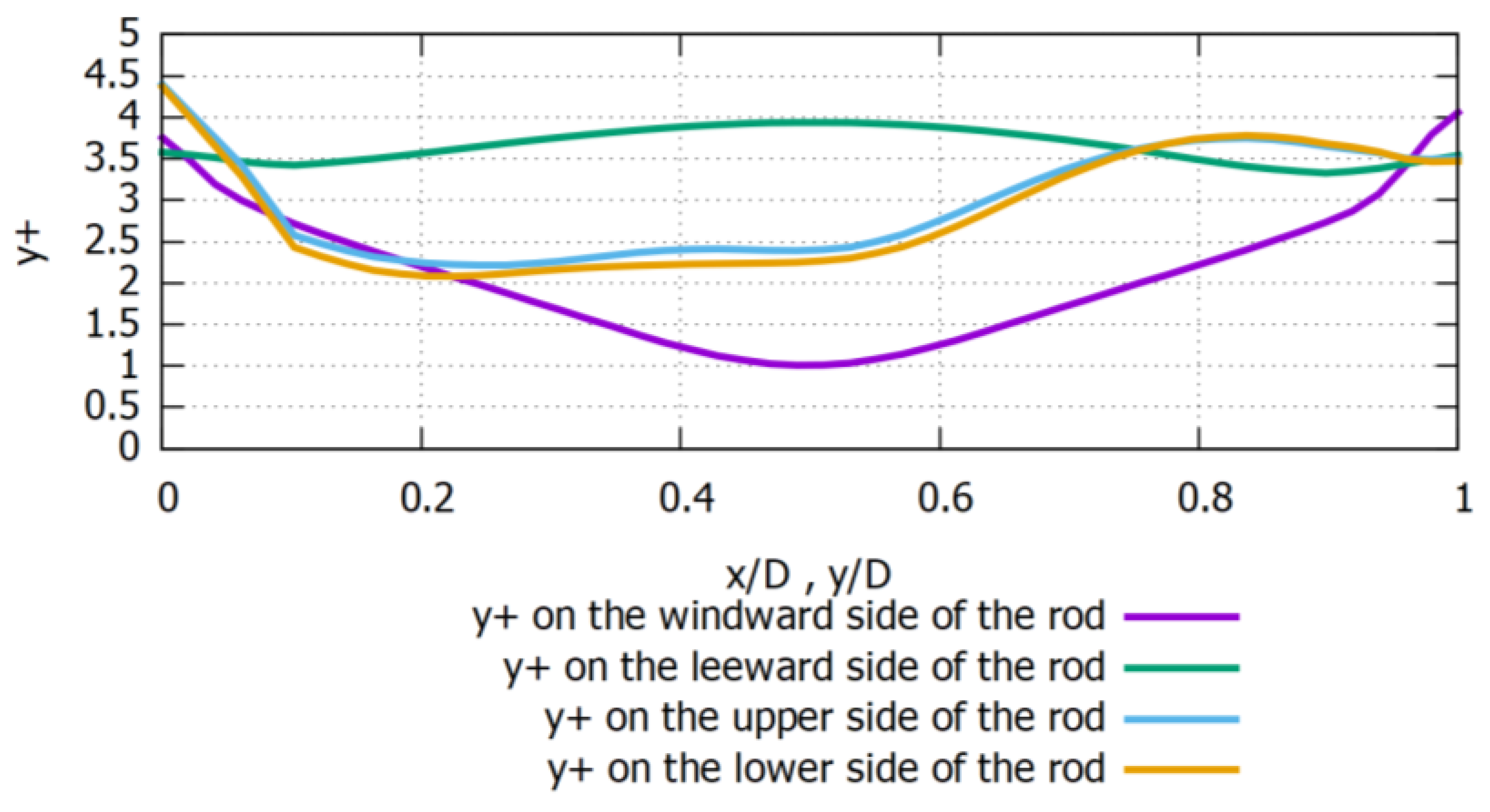
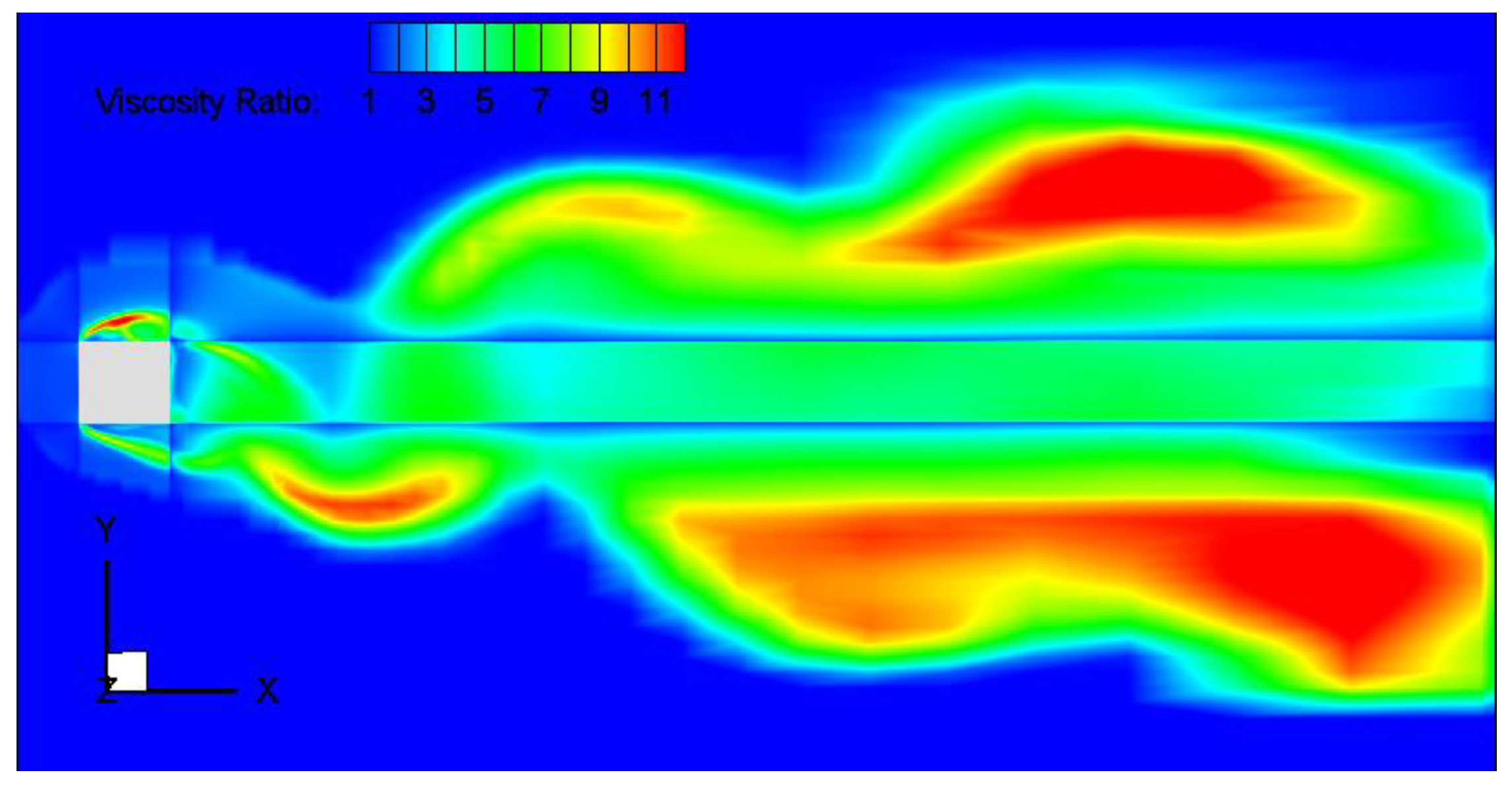
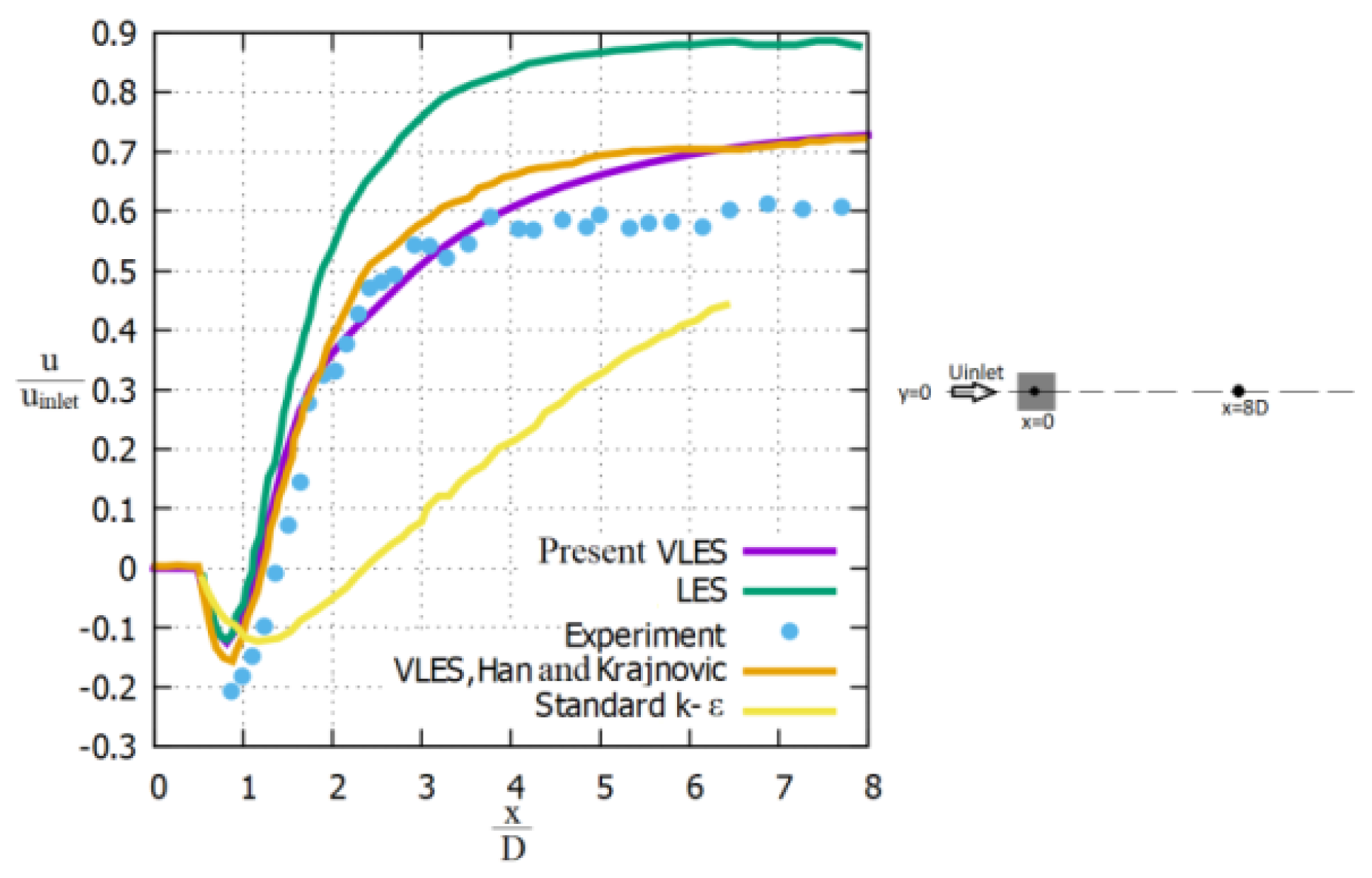
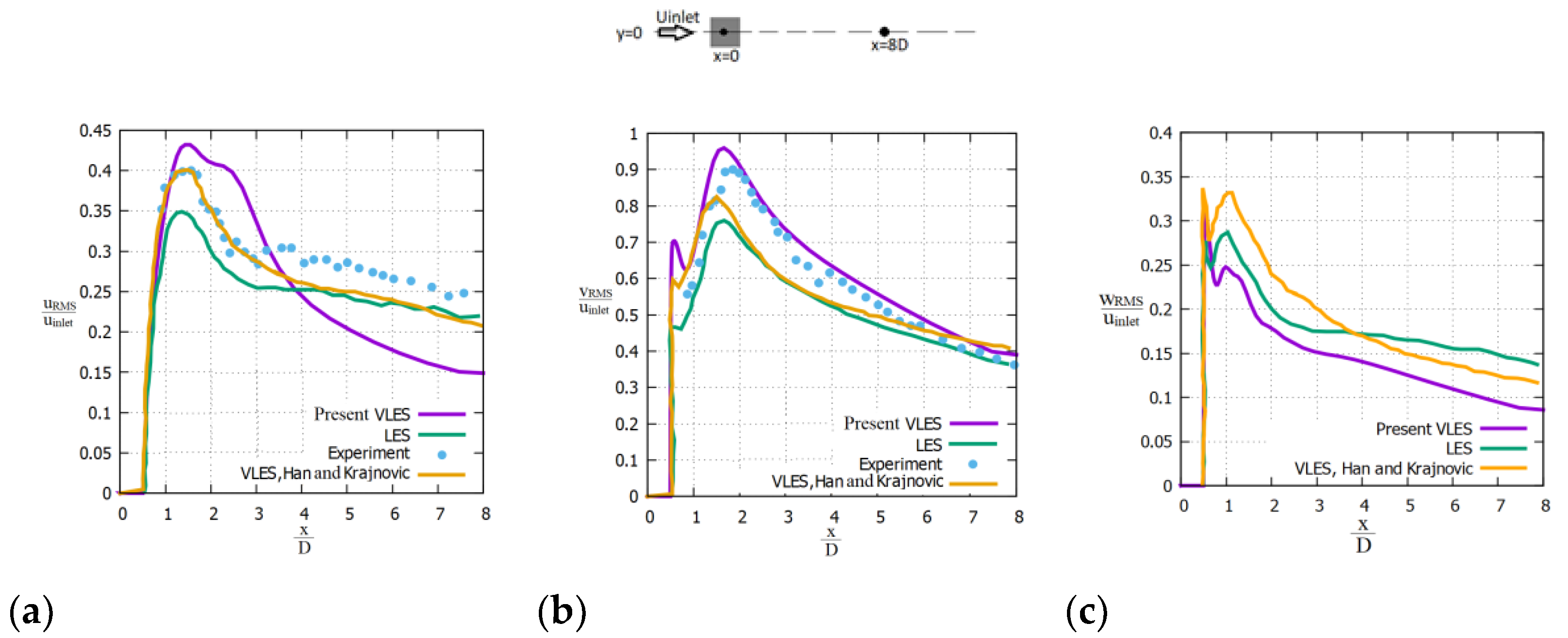
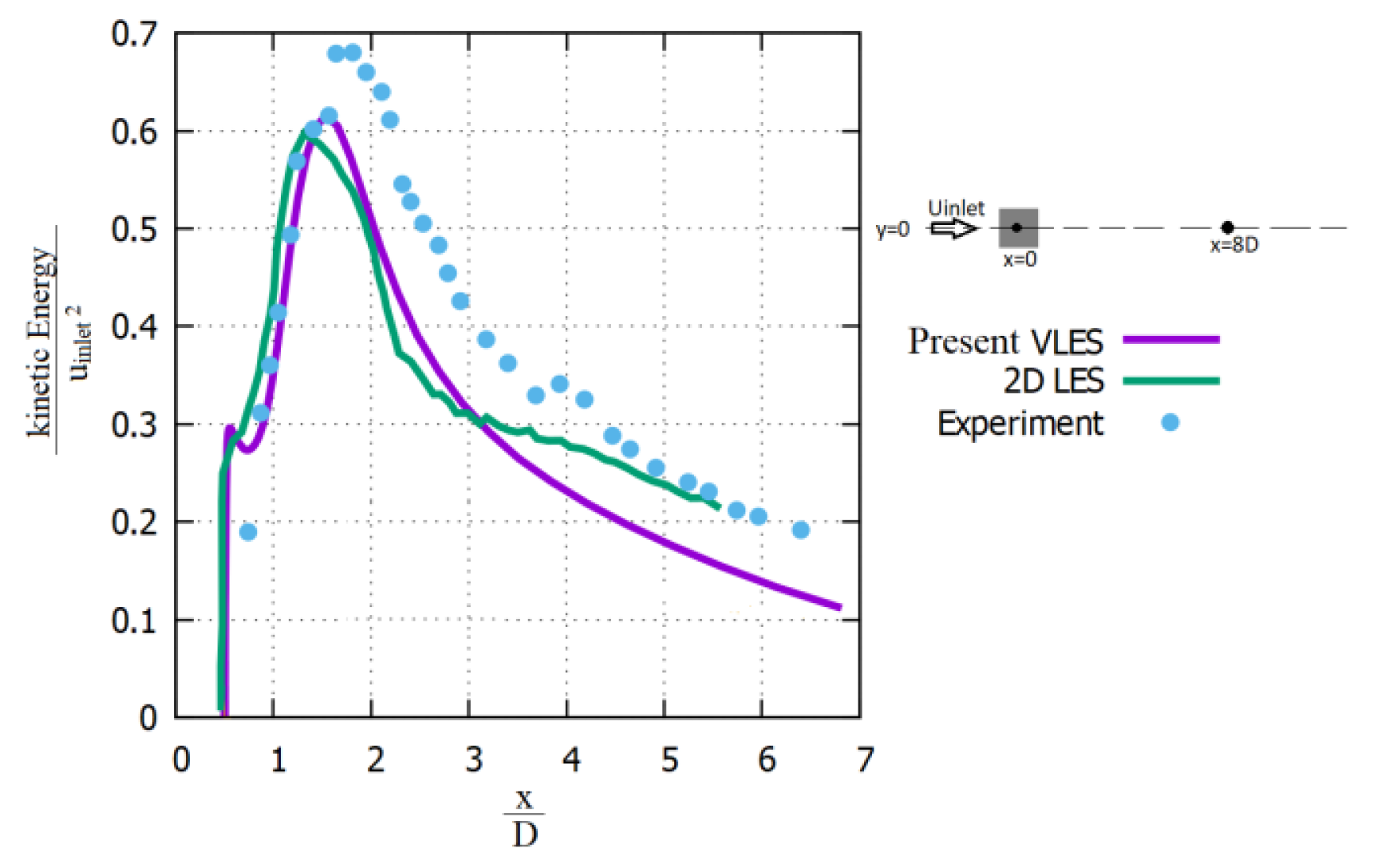
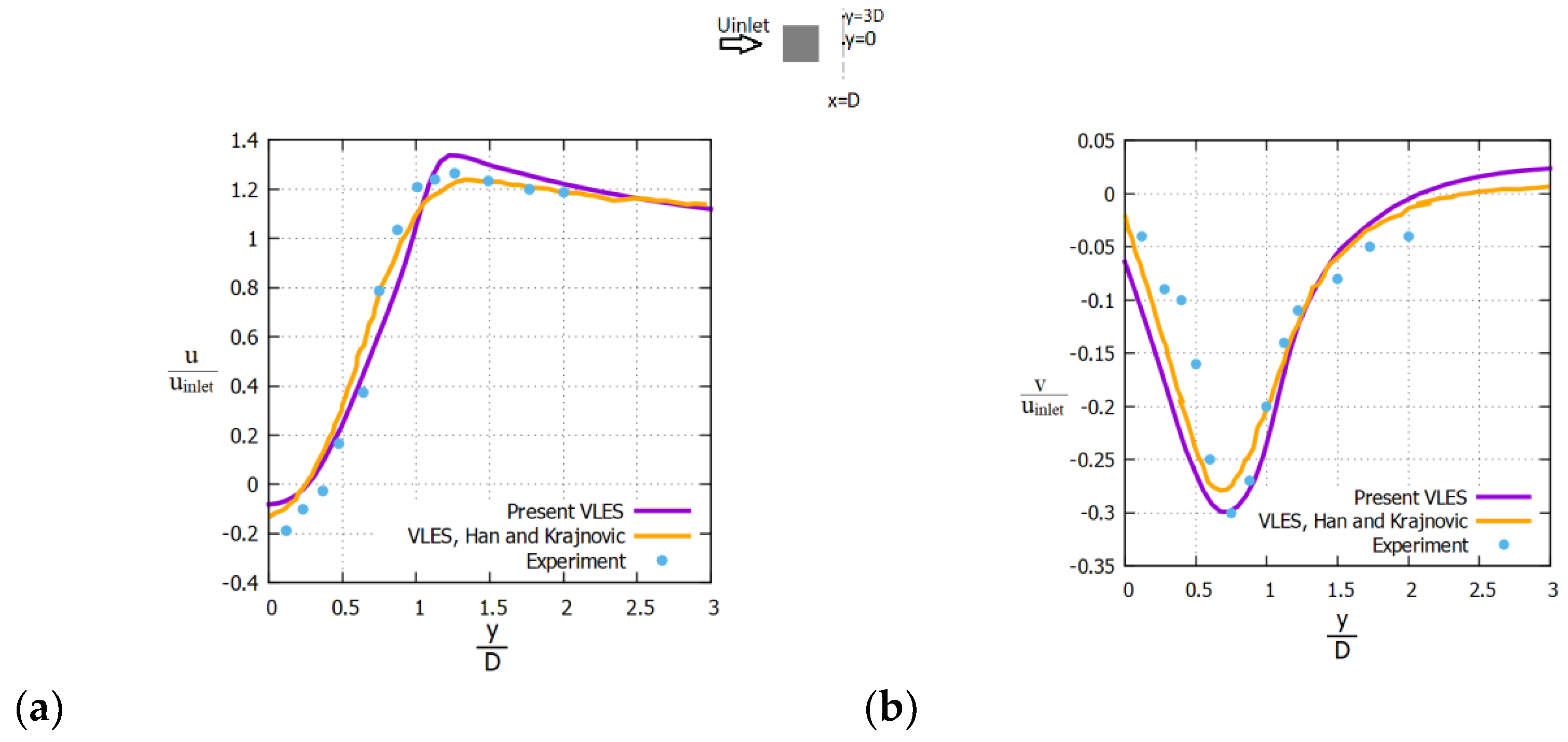

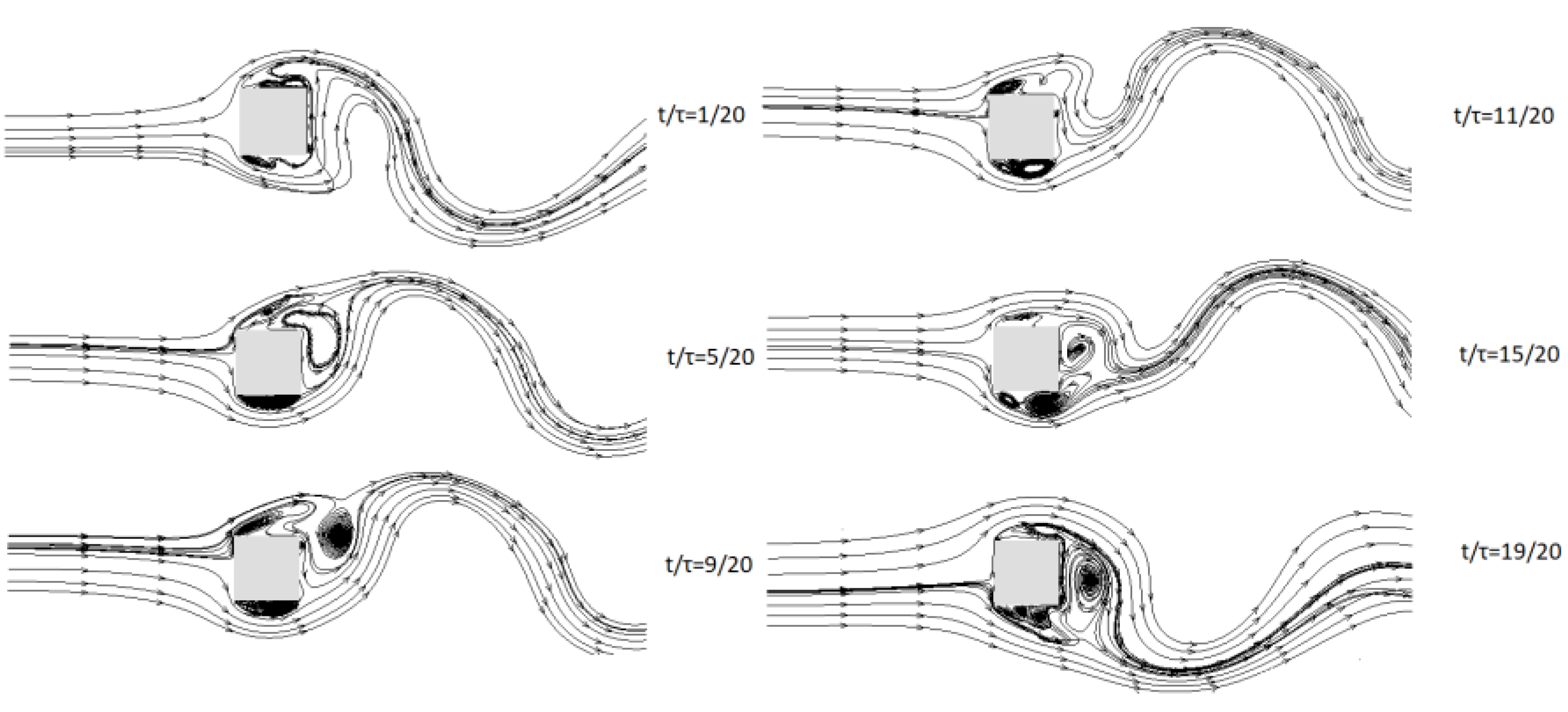
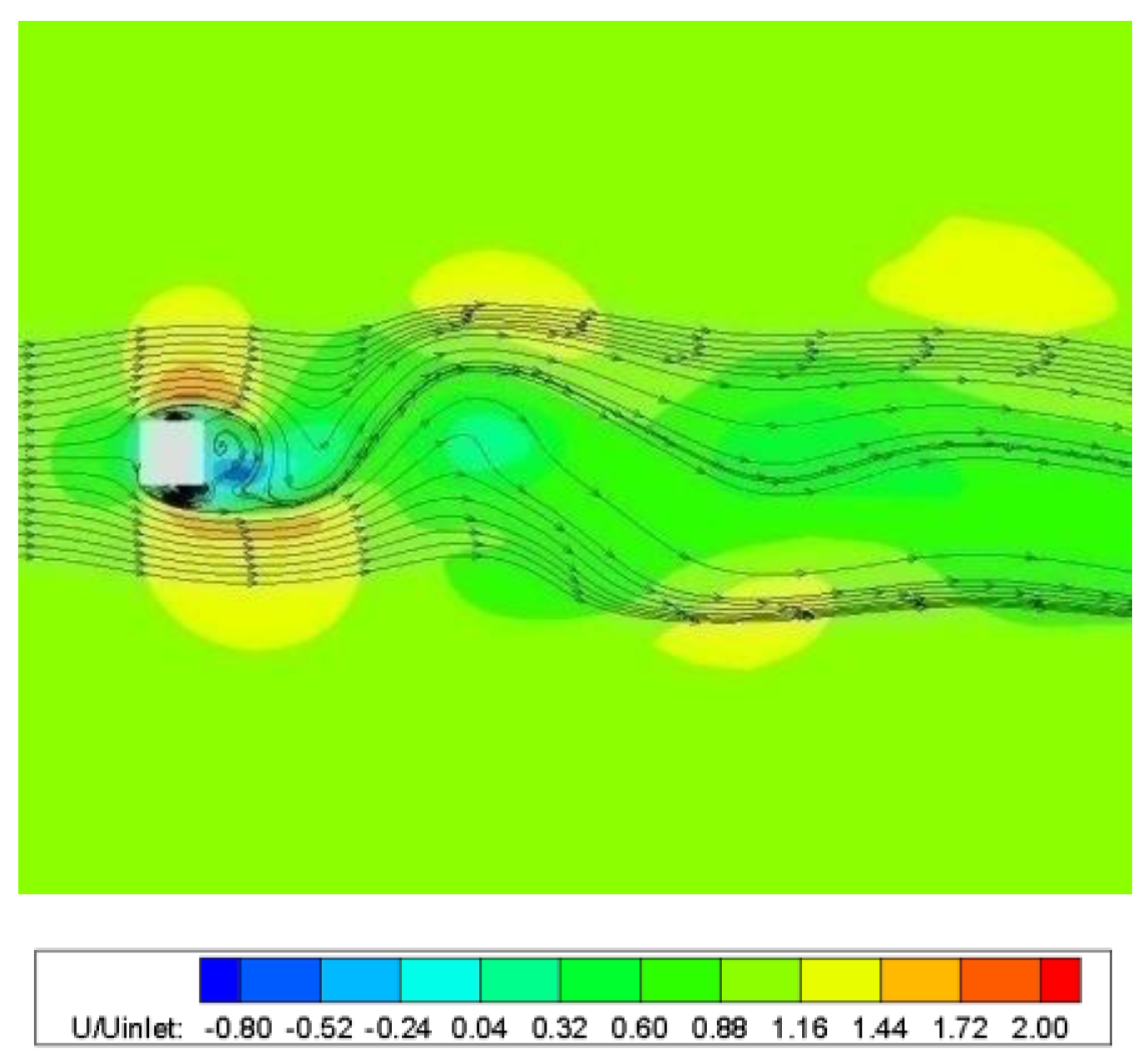
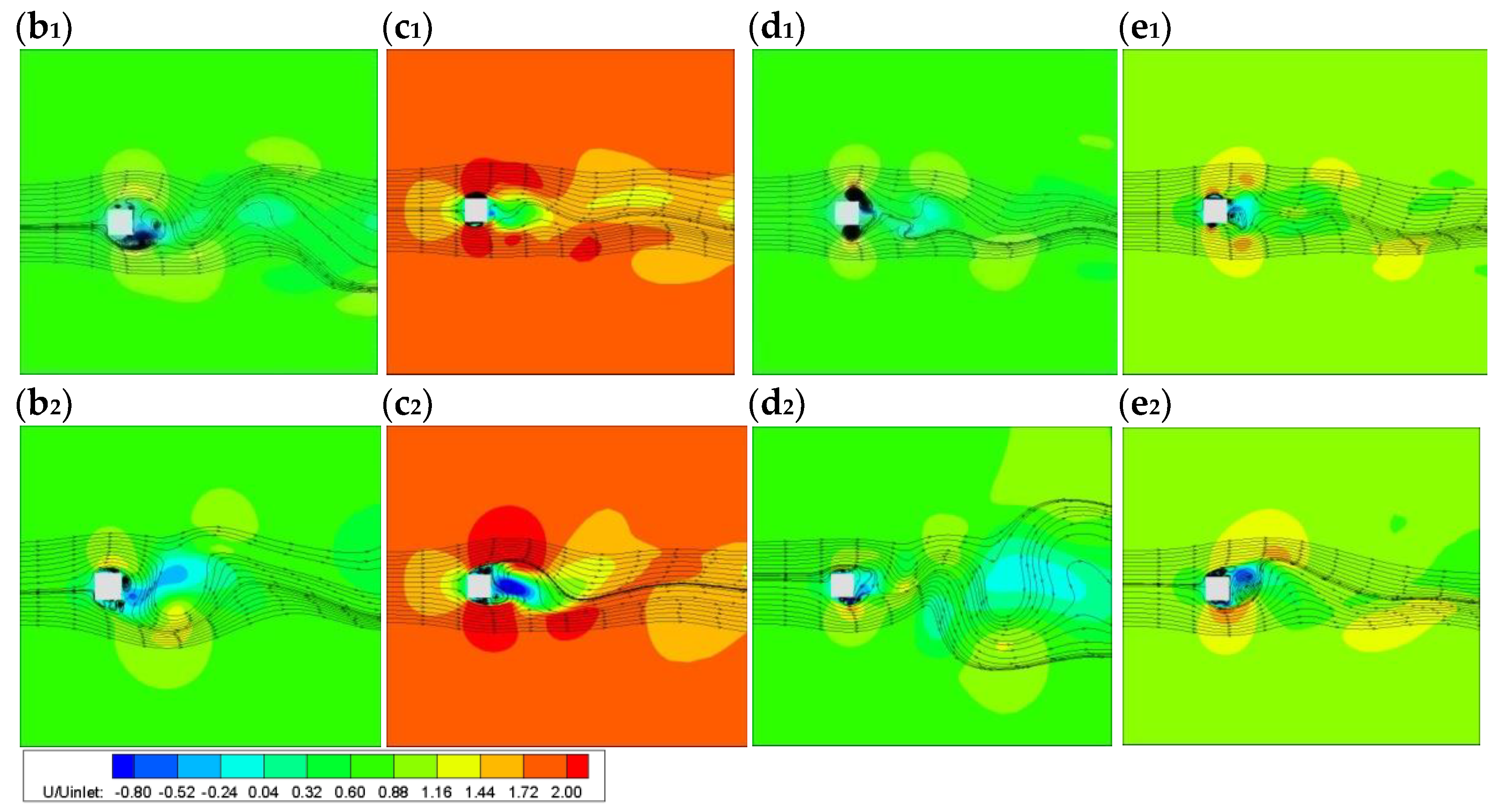
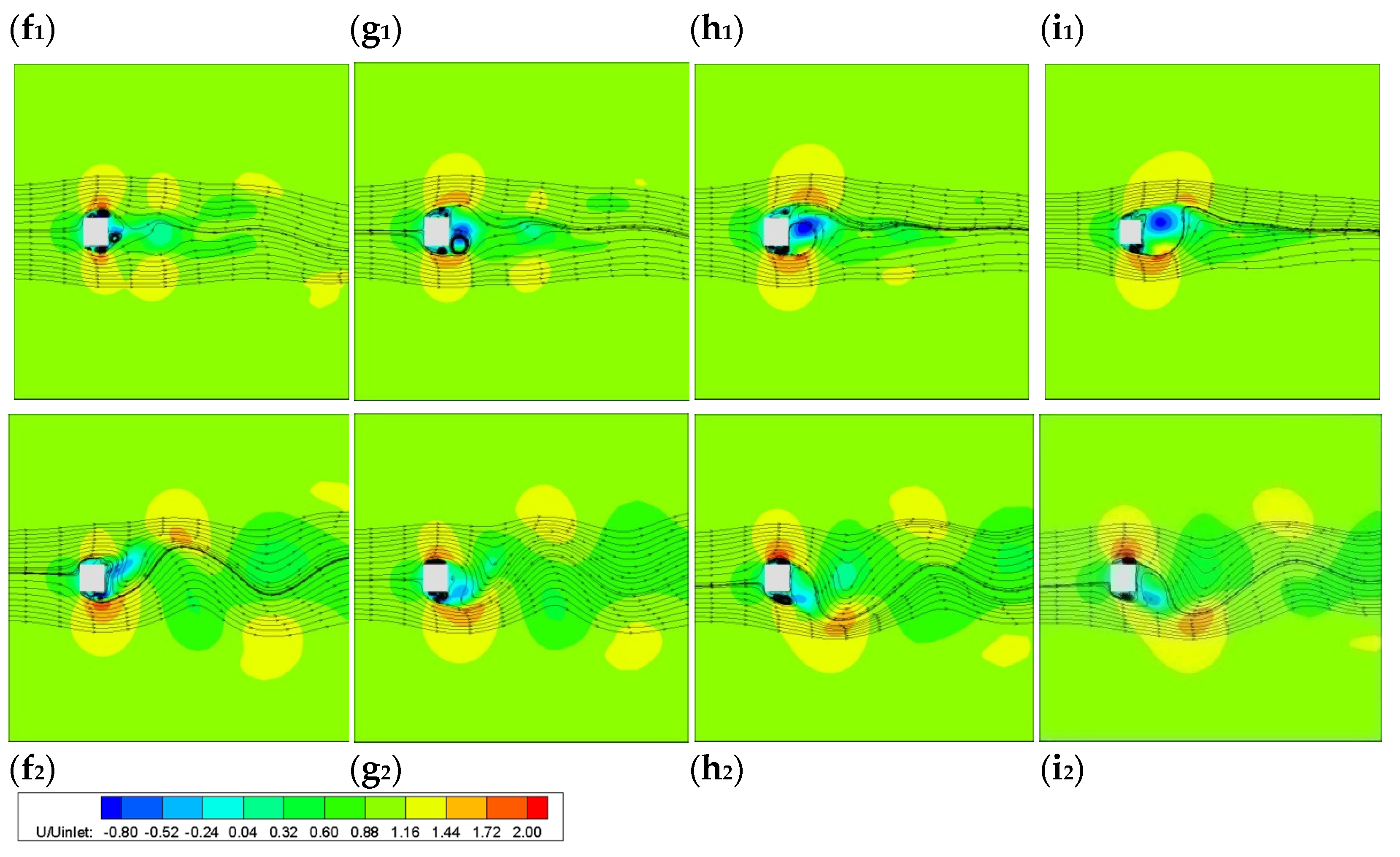

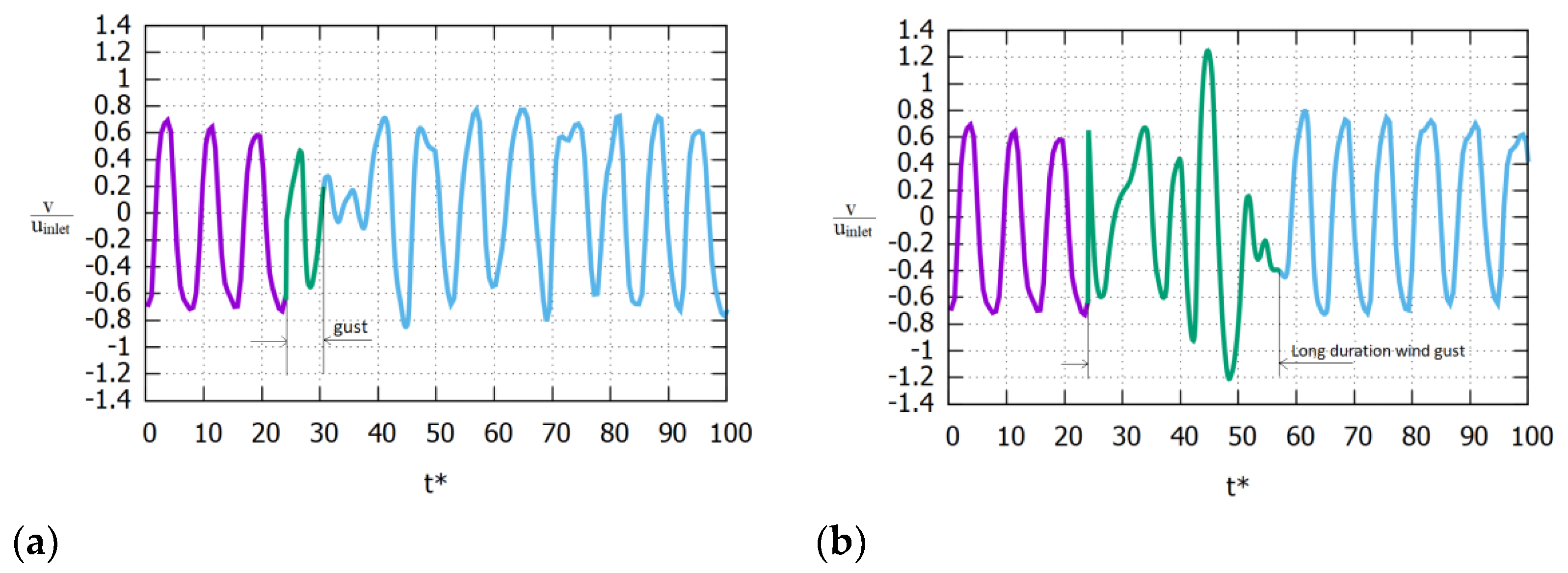
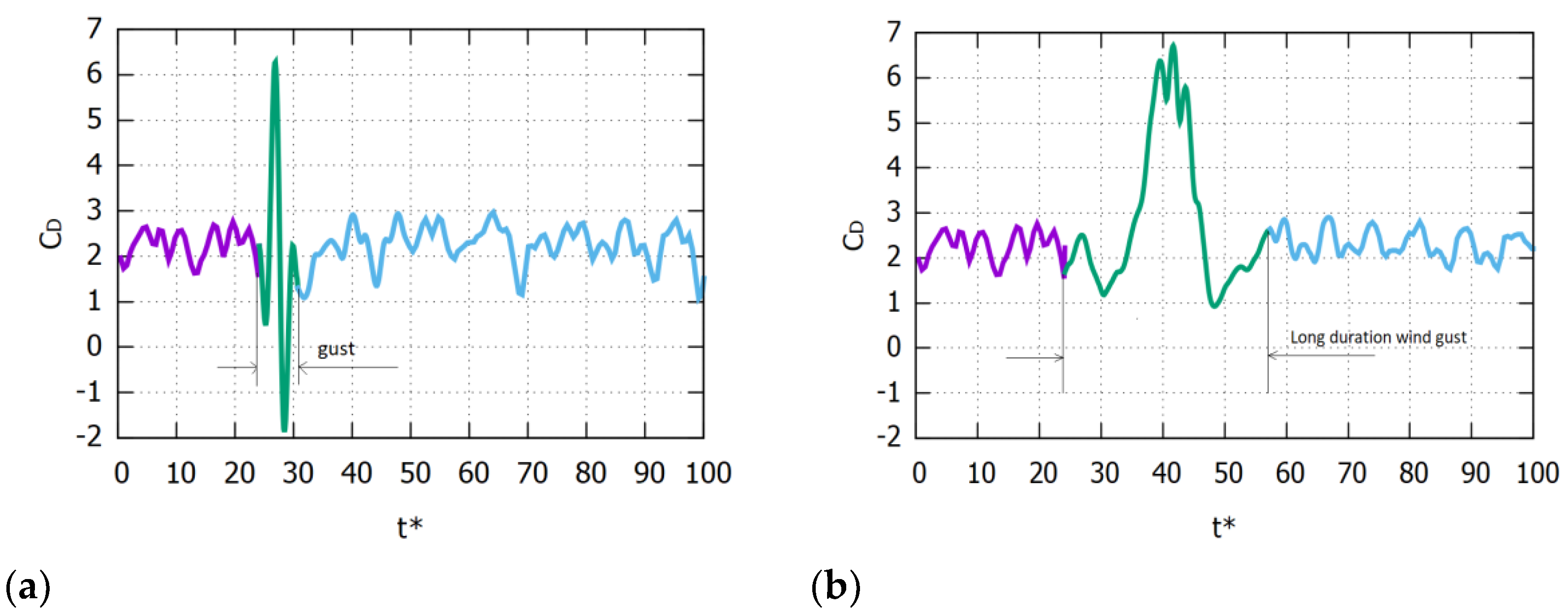
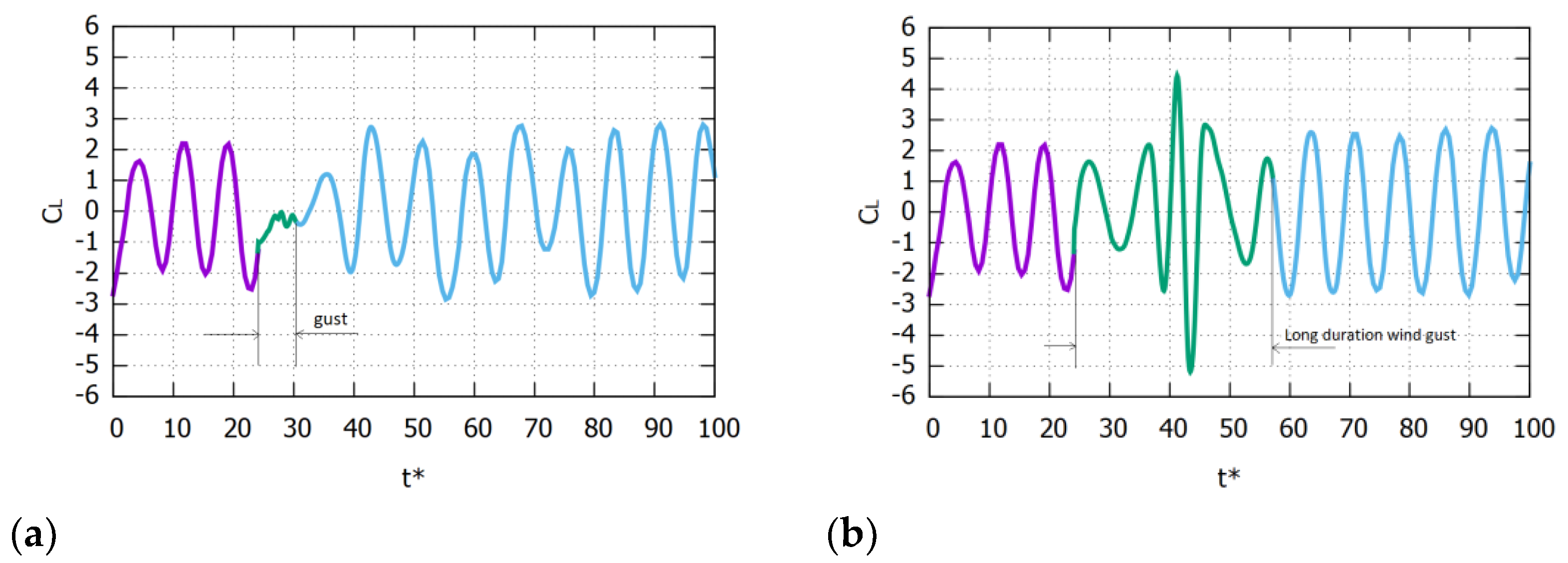

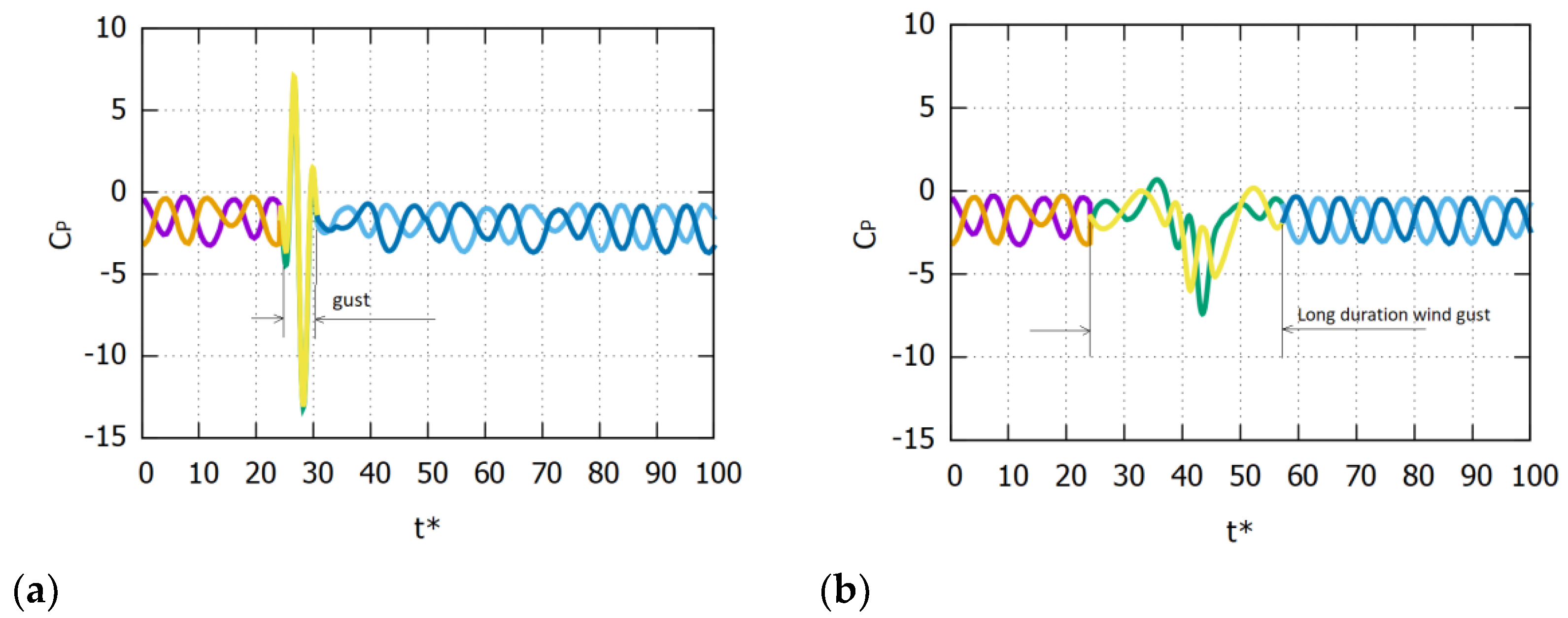

| Re | <CD> | CDrms | CLrms | |
|---|---|---|---|---|
| Present VLES-M378 (No-slip wall) | 22,000 | 2.28 | 0.22 | 1.62 |
| Present VLES-M378 (Free-slip wall) | 22,000 | 2.25 | 0.27 | 1.61 |
| Present VLES-M575 (No-slip wall) | 22,000 | 2.33 | 0.22 | 1.64 |
| VLES -M1 [55] | 22,000 | 2.21 | 0.18 | 1.36 |
| VLES -M2 [55] | 22,000 | 2.28 | 0.19 | 1.51 |
| LES [47] | 22,000 | 2.03–2.32 | 0.16–0.20 | 1.23–1.54 |
| DES [52] | 19,400 | 2.11 | 0.26 | 1.16 |
| Experiment [45] | 21,400 | 2.10 | - | - |
Publisher’s Note: MDPI stays neutral with regard to jurisdictional claims in published maps and institutional affiliations. |
© 2022 by the authors. Licensee MDPI, Basel, Switzerland. This article is an open access article distributed under the terms and conditions of the Creative Commons Attribution (CC BY) license (https://creativecommons.org/licenses/by/4.0/).
Share and Cite
Kotsiopoulou, M.; Bouris, D. Numerical Simulation of the Effect of a Single Gust on the Flow Past a Square Cylinder. Fluids 2022, 7, 303. https://doi.org/10.3390/fluids7090303
Kotsiopoulou M, Bouris D. Numerical Simulation of the Effect of a Single Gust on the Flow Past a Square Cylinder. Fluids. 2022; 7(9):303. https://doi.org/10.3390/fluids7090303
Chicago/Turabian StyleKotsiopoulou, Maria, and Demetri Bouris. 2022. "Numerical Simulation of the Effect of a Single Gust on the Flow Past a Square Cylinder" Fluids 7, no. 9: 303. https://doi.org/10.3390/fluids7090303
APA StyleKotsiopoulou, M., & Bouris, D. (2022). Numerical Simulation of the Effect of a Single Gust on the Flow Past a Square Cylinder. Fluids, 7(9), 303. https://doi.org/10.3390/fluids7090303








